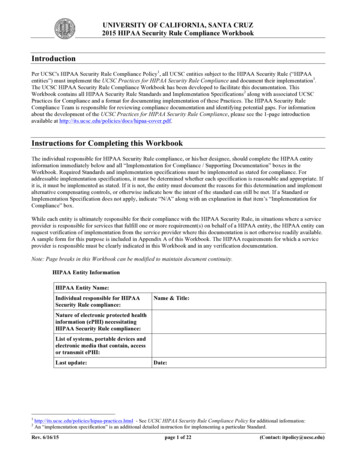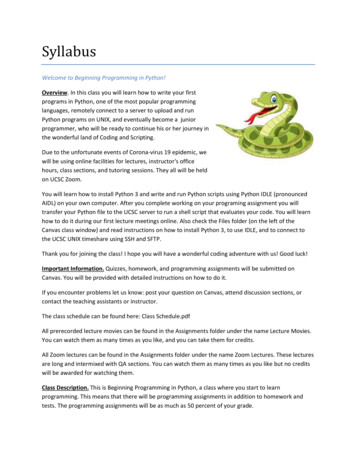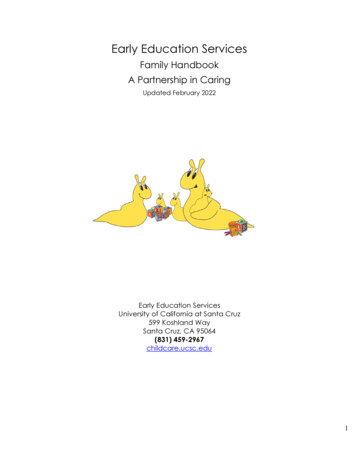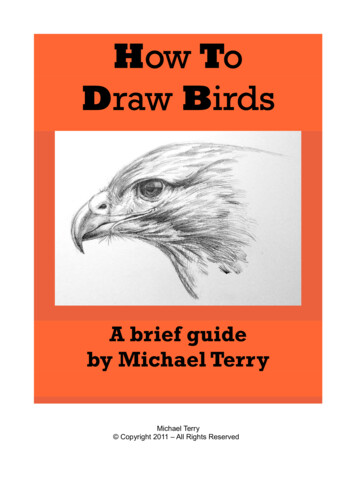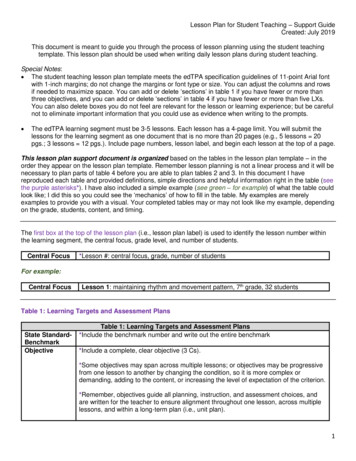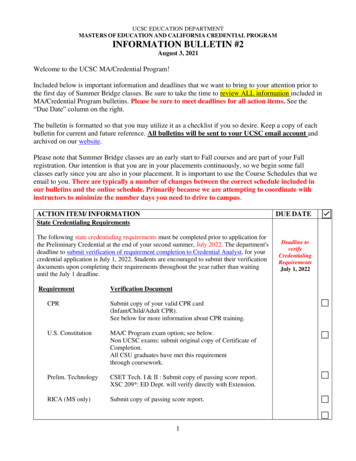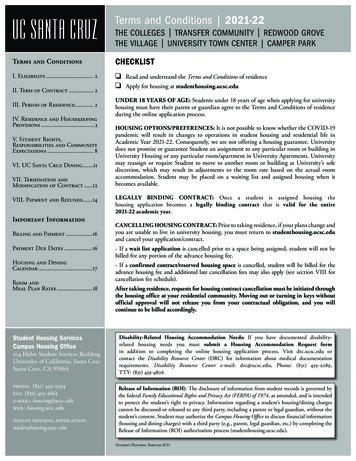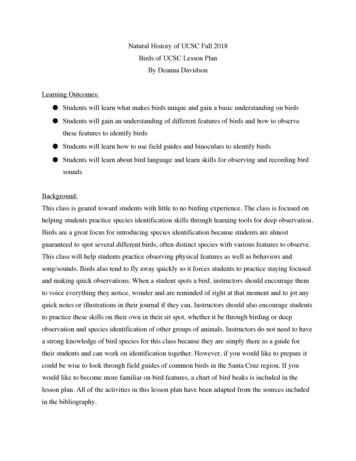
Transcription
Natural History of UCSC Fall 2018Birds of UCSC Lesson PlanBy Deanna DavidsonLearning Outcomes: Students will learn what makes birds unique and gain a basic understanding on birds Students will gain an understanding of different features of birds and how to observethese features to identify birds Students will learn how to use field guides and binoculars to identify birds Students will learn about bird language and learn skills for observing and recording birdsoundsBackground:This class is geared toward students with little to no birding experience. The class is focused onhelping students practice species identification skills through learning tools for deep observation.Birds are a great focus for introducing species identification because students are almostguaranteed to spot several different birds, often distinct species with various features to observe.This class will help students practice observing physical features as well as behaviors andsong/sounds. Birds also tend to fly away quickly so it forces students to practice staying focusedand making quick observations. When a student spots a bird, instructors should encourage themto voice everything they notice, wonder and are reminded of right at that moment and to jot anyquick notes or illustrations in their journal if they can. Instructors should also encourage studentsto practice these skills on their own in their sit spot, whether it be through birding or deepobservation and species identification of other groups of animals. Instructors do not need to havea strong knowledge of bird species for this class because they are simply there as a guide fortheir students and can work on identification together. However, if you would like to prepare itcould be wise to look through field guides of common birds in the Santa Cruz region. If youwould like to become more familiar on bird features, a chart of bird beaks is included in thelesson plan. All of the activities in this lesson plan have been adapted from the sources includedin the bibliography.
Materials: Binoculars for each student 4 field guides 4 bird specimen of common/relatively easy to identify birds Sound graph example White board White board markersPlan for the Day:Meet and Quiz: Duration: 30-40 minutesMeet at the music center. Have people go around and share nature notes from their sitspots/weeks while we wait for every student to show up. Once a lot of students show up, collecthomework and begin quiz.Intro to Birds: Duration: 15 minutes Open with a poem about birds Pair share: What do we know about birds, why are they unique, why do we care? Askwhat makes birds unique from all other animals-(feathers, hollow bones) Bring back tobig group talk. Explain qualitative vs. quantitative observations ( 5 min):Talk about why qualitative observations are important in birding: We must practicemaking quick observations when birding because we may only be able to observe the birdfor a short moment before it flies away. This is why it is important to encourage studentsto use their journal to record everything that they see and notice. This will make theprocess of identifying the bird through a field guide later much easier. Have studentsbrainstorm other things they can notice about birds besides just color. (ex: bill shape, feetshape, size, body shape, tail length, leg length, behavior, songs) (From Sheyna’s lesson) Bird features ( 5 min)
Ask students: What are some different features we can notice about birds besides justcolor? What do different bird features say about their lifestyle?: Draw some bird bills ona whiteboard to discuss. Draw a generalist beak, seedeater beak, and meat eater beak.What other beak shapes can anyone think of? What do you all think this bird eats?(Other features to discuss can include feet, wingspan/shape, body shape, patterns, leglength, behavior, sounds, etc.) (From Sheyna’s lesson)9:20- Observation Activity-Duration: 20 mins To practice observing and identifying birds, have a TA or instructor dress up in aflashy/strange outfit and have the students take out their journals. Let the students knowthat they are about to see a strange specimen appear and to record everything theyobserve in detail, including as many different features as possible. Then signal for thespecimen to appear, do their thing for a short amount of time and disappear again. Whenthey have disappeared, see if anyone can describe the specimen without having thempresent. Then you can have the specimen come out again and compare the description toreality. ( 5 min) (from Sheyna’s lesson) Go over field guides: Explain that field guides should be used after you have observeddeeply and recorded a good amount of information about a bird in your journal. Once youhave enough information to go off of, you can start looking through a field guide toidentify your species. Explain to students that most field guides include a range map thatshows residency and what seasons they are in depending on their migration patterns.Point the maps out to students and explain that they are usually color coded, oftendifferently depending on the guide. Make sure students know that range maps are veryimportant to look at because whether or not the bird you think you are seeing is commonenough in your region during the time you are in can be the final deciding factor whendetermining species. Other things you can point out about the field guides are to look forsound descriptions and to pay attention to male vs female features. ( 5 min) (FromSheyna’s lesson) Split students into groups of 4ish. Give each group a specimen to observe for 5 minutes.Have them discuss and write down everything they observe. Then take the specimenaway (it flew away!!) and hand each group a field guide. They have 5 minutes to try to
guess what bird it is. If a group finishes right away, you can give them another specimen.Then once everyone has a guess, have each group share their guess and evidence to thegroup. (From Rozy’s lesson)9:45- Binos & Birding (each instructor type takes a group) -Duration: 1 hourFrom sheyna’s lesson: “Show everyone the key features of binos- they only focus, they don’tzoom in or out. Explain the eyecups and which dials to turn to focus. The small end of the binosare the ones you look through and don’t walk or run while you bino. In addition, spot what youare going to look at, then bring the binoculars to your face. Otherwise it will be disorienting totry to find your target through your binos.” You can have students choose something aroundthem to focus on. “Go through the instructions for closing one eye while you focus and thenswitching and focusing the eye cup dial to calibrate the binos.” (Haisman-Holmes, 2017) Onceeveryone is comfortable with the binos, go birding! Encourage students to make an entry in theirjournal. Everytime you see a new bird, have students observe deeply and point out all thedifferent identifying features they see. Ask them if they have any guesses to what the bird mightbe. Then, see if together you can identify the bird in your bird guide. Have students keep track ofall the birds they observe, preferably in their journal.Bird Language -Duration: 20 minutes (from Beetles lesson and Rozy’s lesson) “Finger Listen.” Gather the group and have everyone silently focus on listening to all thebird sounds around them, and hold up a finger for each new bird they here. (1 min) Letstudents know they’ll be learning about the language of birds which will help them betterunderstand bird behavior, interactions and other things going on in the environment.(From Bird Language Exploration) Pair share: What kinds of messages might birds need to communicate, and how mightthey help with survival? What might these calls sound like? Bring back to whole groupdiscussion ( from Bird Language Exploration) Share brief information/examples about each “category” of call. Describe or demonstrateexamples of each type of communication, but keep these descriptions brief. (from BirdLanguage Exploration)
Songs are often used to alert others about territory & attracting a mate. Aggression calls and alarm calls are often loud and abrupt sounding. Short call notes are often used to stay in contact with others Young birds make begging calls to ask for food. Discuss qualities to pay attention to: pitch, tone/quality (smooth, raspy, etc.), speed andacceleration, rhythm and repetition, phrases. Introduce sound mapping. (from Rozy’slesson) Pair share if time: what are some tools we can use to remember bird calls?Sound mapping -Duration: 30 minutes (From Rozy’s lesson)Introduce the tools of sound graphing and sound mapping. You can draw a sound graph on awhiteboard or piece of paper. Have students find a solo spot in nature and make a sound map(with them in the center) of all the different birds they hear. For each bird, they can draw a soundgraph. They can also try describing the pitch, tone, speed, etc. in words and/or come up with acatch phrase for each call they hear. They can also try to guess what the bird might be trying tocommunicate. At the end, have everyone come together again and anyone who wants to shareabout their experience and/or a song they heard can do so. Conclude with any important classannouncements.Bibliography:Bathrick, Rozy. “Bird Language 101.” Natural History Field Quarter. 2017, Angelo Reserve.“Bird Language Exploration - Beetles Project.” Beetles Project, The Lawrence Hall of es, Sheyna , 2017. “Envs15 Birds Lesson Sheyna 2017” (google doc). ENVS15student-developed curriculum.
Natural History of UCSC Fall 2018 Birds of UCSC Lesson Plan By Deanna Davidson Learning Outcomes: Students will learn what makes birds unique and gain a basic understanding on birds Students will gain an understanding of different features of birds and how to observe

